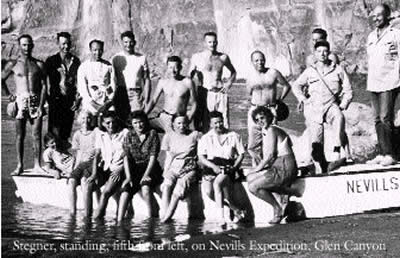
Powell and Stegner: Challenging Western Myths
“Water is the true wealth in a dry land; without it, land is
worthless or nearly so.” —Wallace Stegner
 Ponder
this: Utah is in its fourth consecutive year of drought and there is talk
of water rationing this summer. And even if the drought is broken the
threat of its return is ever present in the arid West. With an annual
average rainfall of 13 inches, Utah is the second driest state in the
nation (next to Nevada). Nevertheless, Utahns are notorious water consumers,
slurping up 262 gallons of water a day, which amounts to the second highest
per capita water use in the country.
Ponder
this: Utah is in its fourth consecutive year of drought and there is talk
of water rationing this summer. And even if the drought is broken the
threat of its return is ever present in the arid West. With an annual
average rainfall of 13 inches, Utah is the second driest state in the
nation (next to Nevada). Nevertheless, Utahns are notorious water consumers,
slurping up 262 gallons of water a day, which amounts to the second highest
per capita water use in the country.
With the steady increase in the state’s population, Utahns are becoming
ever more dependent on the damming up and storing of water. Now, with
the forecast that the state will add a million more people in just 20
years, an obvious question arises: how can such a massive population increase
be accommodated?
In attempt to answer this question, the University undertook various initiatives
this past year covering a wide range of water-related issues. One of these
was the Seventh Annual Symposium of the Stegner Center for Land, Resources
and the Environment at the S. J. Quinney College of Law, “Powell
& Stegner: Fifty Years after The Hundredth Meridian.”
The focus of the symposium was Pulitzer Prize-winning author Wallace Stegner
BA’30 (see Continuum, Winter 1995-96) and his internationally
acclaimed book, Beyond the Hundredth Meridian: John Wesley Powell and
the Second Opening of the West. The symposium marked the 100th anniversary
of the death of Powell—explorer, scientist, and adventurer—who
left an indelible mark on the history of the United States, particularly
on the course of events in the West.
The story of water in the West can be traced back to the summer of 1869,
when Major Powell, a one-armed Civil War veteran, led a small group of
amateur scientists and mountain men on an exploration of the Green and
Colorado river regions, an area little known by non-Indians. The only
feasible way to gain access through the Grand Canyon of the Colorado—279
miles of roiling rapids and unknown, uncharted territory—was by boat,
which no European American had ever attempted.
 It seemed
unlikely that Powell and his team of tenderfoots would emerge with anything
more useful than the saving of their skins. Ultimately, however, Powell
did reappear, after a harrowing journey and the loss of a few good men.
The information he had gathered would have major implications for the
future development of the western United States.
It seemed
unlikely that Powell and his team of tenderfoots would emerge with anything
more useful than the saving of their skins. Ultimately, however, Powell
did reappear, after a harrowing journey and the loss of a few good men.
The information he had gathered would have major implications for the
future development of the western United States.
Seven years and another trip down the Colorado later, Powell submitted
his findings to the federal government in A Report on the Lands of
the Arid Region of the United States, with a More Detailed Account of
the Lands of Utah. The 200-page report outlined his recommendations
for the development of the region. At the same time, it challenged the
prevailing views of the West, chipping away at mountain-man myths and
romantic fantasies given currency by railroad entrepreneurs, land speculators,
developers, and politicians of all stripes.
The report was widely disputed by self-styled Western “experts”
who saw the region as a land of infinite open space and untapped natural
resources ripe for development. The West’s destiny, they claimed
in chorus, was manifest.
Leading the choir was the territorial governor of Colorado, William Gilpin,
whose voice resonated all the way to Washington. Stegner describes Gilpin
as “[a man who] saw the West through a blaze of mystical fervor,
as part of a grand geopolitical design, the overture to global harmony;
and his conception of its resources and its future for a home of millions
was as grandiose as his rhetoric, as unlimited as his faith, as splendid
as his capacity for inaccuracy.” The clash between opposing views—Powell
vs. Gilpin, the practical realists vs. the fabulists—continues to
resound to this day.
 It is this
state of affairs that Stegner examines in Hundredth Meridian (the
invisible boundary running through Nebraska, Kansas, and Oklahoma that
separates the eastern part of the United States, where annual rainfall
is over 20 inches, and the western part, where it is less.) Published
almost 50 years ago, the book has served as a landmark in American literature
ever since. It has drawn attention to misconceptions about the West and
the fragility of its resources, spurring a fledgling environmental movement
that has gathered force to become an authoritative, if often contested,
voice in the contemporary West.
It is this
state of affairs that Stegner examines in Hundredth Meridian (the
invisible boundary running through Nebraska, Kansas, and Oklahoma that
separates the eastern part of the United States, where annual rainfall
is over 20 inches, and the western part, where it is less.) Published
almost 50 years ago, the book has served as a landmark in American literature
ever since. It has drawn attention to misconceptions about the West and
the fragility of its resources, spurring a fledgling environmental movement
that has gathered force to become an authoritative, if often contested,
voice in the contemporary West.
The interplay between Powell and Stegner was the focal point of the Stegner
Center symposium. Comments Keith Bartholomew, the center’s associate
director and organizer of the event, “Both Powell and Stegner, in
their own ways and own times, had a profound impact on the way the West
is viewed, both inside and outside of Utah. Powell was an explorer of
geography, Stegner an explorer of literature; together they defined the
modern image of the American West.”
Keynote speaker Charles Wilkinson, Distinguished University Professor
and Moses Lasky Professor of Law at the University of Colorado, observes,
“Powell was perhaps the greatest Western thinker of the 19th century
and Stegner was probably the greatest of the 20th. Stegner explained the
real history of the West—the shortsightedness and the treachery,
but also the civility and cooperation that were the truest and best Western
traditions.”
Powell essentially created a “blueprint for a dryland democracy,”
writes Stegner. He examined the area west of the 100th meridian—a
region of disputes, feuds, and misconceptions, where the “only unity
was the unity of little rain”—and proposed a program for development
that would take into consideration its topography and unique characteristics,
in particular its limited water resources.
By so doing, Powell challenged the popularly held belief that “rain
follows the plow”—that is, that tilling the soil actually increases
the annual rainfall, or that as the population grows, the moisture intensifies.
Fuzzy forecasting aside, this belief was inculcated by those, such as
Gilpin, who wished the myth into the popular imagination.
Growth and development were concepts that spurred the unprecedented westward
expansion of the 19th century, as embodied by Mormon pioneers who arrived
in the Great Salt Lake Valley in 1847. What they saw upon arrival was
a vast, desolate-looking land. Ever enterprising, the pioneers set up
a system of irrigation that would eventually “make the desert bloom,”
thereby establishing a pattern for other Western states to follow.
A century later, the population of Utah has blossomed to over two million
inhabitants and continues to grow exponentially. While this seems a drop
in the bucket compared to more densely populated regions of the world,
the fact is the shortage of water that already exists will obviously become
more severe as the population increases.
Water, water, everywhere…
“The subject of water in the West is a huge topic,” says Peter
H. DeLafosse, who, as chair of the 2002 Keepsake Committee of the Friends
of Marriott Library, is well versed on Stegner and Powell and their concern
over water issues. “You can’t talk about the West without considering
water.”
Indeed, the topic of water was widely dealt with at the U this past year.
The American West Center, under the direction of Daniel McCool, professor
of political science, has initiated a study of federal water policy, specifically
examining how national water objectives have changed from a policy focused
on structural solutions—such as dams, diversions, levees, and channelization—to
a policy emphasizing river restoration and ecosystem preservation, including,
in some cases, the removal of dams. While tearing down dams may seem to
fly in the face of water conservation, the opposite is true. Explains
McCool, “The idea is to move from water development, or structural
solutions, to water management—that is, using water more wisely.
For a century, political incentives were biased toward development regardless
of whether it made economic or ecological sense. This has resulted in
massive waste of water and money, and enormous damage to the environment.
As a result,” says McCool, “most of the West’s water resources
today are allocated to uses that are illogical and economically nonviable”—to
hay, for example, the West’s principle crop, which is a low-value
but high water-consuming crop. “In many cases,” he says, “the
water that is used to flood hay fields is worth more than the hay. And
if we didn’t heavily subsidize these uses, they would not occur.
Wise water management would price water at its market value, and public
waters would be used for public purposes such as recreation, parks, and
habitat preservation. This would be good for the economy, the taxpayers,
and the environment.”
University alumni and staff are involved in “Moving Waters: The Colorado
River and the West,” a project sponsored by the humanities councils
of the seven Western states that share the waters of the Colorado. The
project includes a traveling exhibit, a six-part radio series, a lecture,
and a reading and discussion program in each location, and explores crucial
issues regarding the human encounter with and use of the Colorado River
and its tributaries. Philip F. Notarianni BS’70 MA’72 PhD’80,
adjunct professor of ethnic studies, is the director for the Salt Lake
City programs, and Roy Webb BA’84 MS’91, multimedia archivist
at the Marriott Library, is a discussion leader on the University of Utah
Press publication, A Colorado River Reader, edited by Richard F.
Fleck. The public programs in Utah are being conducted in Salt Lake City,
Moab, and Vernal between April 2002 and September 2002. For more information,
check the project’s Web site at: www.movingwaters.org.
The Marriott Library is contributing to the study of water by proposing
to establish the Western Waters Digital Library (WWDL). According to Kenning
Arlitsch, head of Digital Technologies at the library, “The simple
vision for the WWDL is to create a digital library of water resources
that would act as a central repository for scholars, lawyers, corporations,
government organizations, and lay people.” The brainchild of Marriott
Library director Sarah Michalak and assistant director Greg Thompson,
the collection would house information in formats ranging from photographs,
text, maps, and manuscripts to audio and video holdings, and would cover
a complete range of informational areas, from geography, economics, and
environment to recreation, policy and planning.
The first installment of the WWDL is the diary and photographs from the
Galloway-Stone Expedition of 1909, considered by Colorado River historians
to be the first such river trip undertaken purely for pleasure. Nathaniel
Galloway’s diary, as well as photographs taken from the expedition,
can be viewed online at www.lib.utah.edu/digital/galloway.
Other online contributions by the library include more than 1,000 photographs
of Glen Canyon, which can be viewed on the Photograph Archives Web site
at www.lib.utah.edu/spc/photo,
keyword “Glen.”
WWDL is a cooperative effort by 28 major institutions west of the Mississippi, organized as the Greater Western Library Alliance (GWLA). The success of the proposal will be determined by September 2002.
Associate Professor of Civil and Environmental Engineering Rand Decker BS’78 was recently named a co-recipient of the Bennion Center’s 2002 Public Service Professorship for his work on a broad initiative known as the Headwater Center, in collaboration with faculty at the University of Nevada at Las Vegas. The focus of the project is water resource management in the Colorado River Basin. “The center,” explains Decker, “will serve as an allocation resource. It is designed to be an objective, stand-apart arena in which the varied demands on water use can be assessed.”
An expert on snow hydrology (“85 percent of the Colorado River originates
from snow”), Decker says that one of the most compelling ideas associated
with the project, recently proposed by UNLV professor Greg Leavitt, is
to set up a K-12 school curriculum in natural resources with the idea
of teaching “personal allocation consumption,” where individuals
would learn early on that they need to be “self-policing” regarding
water usage.
Concludes Decker, “The Colorado River, already utilized at 100-plus
percent, will have more demands put on it as the Southwest continues to
grow. The need for a well thought out, overarching policy, including instructional
and technical considerations, will also grow. Utah is, literally, right
in the middle of this.”
Finally, the use (and misuse) of water was the focus of a three-part series,
“Soaking the Desert: The Story of Water in Utah,” broadcast
by KUER radio last winter. The program was reported, written, and produced
by Jenny Brundin and Vince Pearson and edited by Kat Snow, KUER news director.
The entire script is available online at www.kuer.org/water/readlisten/index.html.
“The story of water in Utah,” said Snow, narrating the program,
“is the story of a water system bloated with inefficiency and waste
that unnecessarily costs taxpayers millions of dollars and forces them
to pay for the water use of everyone else on the system.” Moreover,
she continued, “The state’s conservation plan deliberately bypasses
many proven conservation techniques other Western states adopted two decades
ago.”
Water experts who were interviewed explained that the problem is compounded
by the population’s careless ways: Utahns waste up to 25 to 50 percent
of all the water they use outside by relying on automatic sprinkling systems,
which tend to over water by about 44 percent; by planting water-consuming
Kentucky bluegrass lawn, rather than native, drought-resistant grasses;
and by growing gardens of water-needy types of vegetation rather than
native shrubs and flowers.
 |
Solutions to the problem are available, even obvious, argued water managers, but no one seems capable of addressing the problems directly. For example, Utahns pay among the lowest water rates in the country because real costs are hidden in federal, sales, and property taxes. As a result, monthly water bills reflect only one-half of actual cost. “Incentives should be provided for those who conserve water instead of rewarding those who waste it,” argued Zack Frankel BS’91, director of the Utah Rivers Council.
The message of the KUER program was that the water shortage threat is permanent and will require a change in Westerners’ lifelong cultural attitudes and water usage practices.
Utah is a desert. Get used to it.
It could be argued that if Powell’s advice had been heeded,
Utah and the rest of the West would be in a better position to face these
problems today. At the time, however, Powell’s ideas were either
given scant attention or were spurned.“Science,” writes Stegner,
“had gone down before credulity, superstition, habit.”
Lessons were learned, belatedly, during periods of drought in the late
19th century and again in the 20th, especially during the Dust Bowl era
of the 1930s, which led to the adoption of many of Powell’s suggestions
regarding land classification, unfenced ranges, irrigation regulation,
and development of hydroelectric power. However, in 1953, just before
Hundredth Meridian was published, Stegner remarked that the myth-makers
were still at work, holding sway with public opinion.
“The private interests that [Powell] feared might monopolize land
or water in the West are still there, still trying to do just that,”
writes Stegner. “And the scientific solutions to Western problems
are still fouled up by Gilpins, by the double-talk of Western members
of Congress, by political pressures from oil or stock or power or land
or water companies, by the obfuscations of press agents and the urgings
of lobbyists.”
While the obfuscations will most likely continue, one thing is clear:
Powell was a visionary, a thinker ahead of his time. Contemporary policymakers
would do well to follow his example. Notes Stegner: “Instead of preaching
unlimited supply and unrestrained exploitation, [Powell] would preach
conservation of an already partly gutted continent and planning for the
development of what remained.”
—Linda Marion BFA’67 MFA’71 is managing editor of Continuum.
